|
|
| |
|
|
| |
Cluny
Cottages |
|
| |
| |
Built
in the early 1830’s, the cottages, formerly the
Preventive Houses where the King’s Men, the forerunners
of the customs and excise men lived, are now called
Cluny Cottages. Built with stones from the local quarry,
the red granite lintels came from nearby Stirling Hill.
Slates for the roofs were shipped in by schooner from
Wales and carried up from the shore by the women of
the village in creels strapped to their backs. Each
of the seven single storey cottages originally consisted
of two rooms and an outside toilet. A staircase separated
the two rooms and led to a loft.
The two storey house at the east end of the row is reputed
to have been the Collieston home of Thomas Blake Glover,
the 'Scottish Samurai', whose father was head of the
Coastguard Station in Collieston from 1847 to 1849.
|
| |
|
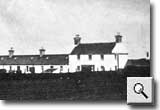 |
| |
|
|
| |
The
Collieston Auxiliary Coastguard Company |
|
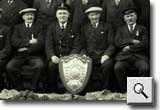 |
| |
The Collieston
Auxiliary Coastguard Company was awarded the Board of
Trade Shield in 1931 for saving the ten-man crew of
the Aberdeen trawler ‘Nairn’ after it had
gone aground in stormy seas on 2nd December at Broadhaven
one mile south of Collieston.
Bronze medals for gallantry in saving life at sea were
also awarded to District Officer Smailes, Coastguardsman
F Shelley and Messrs Walker, Henderson and Robertson.
It was a great occasion for so small a village and the
first time that the shield had been awarded to Scotland.
|
| |
|
|
| |
|
|
| |
The
Collieston Auxiliary Coastguard Company circa 1930.
The company of some 16 men makes its way back to the
village after a rocket practise on the cliffs near the
coastal path leading to Forvie. Hackley Head is clearly
visible in the background.
The Life Saving Apparatus being pulled was stored in
the ‘Rocket Shed’ at the top of Perthudden,
near Cluny Cottages, the former Coastguard Cottages.
|
| |
|
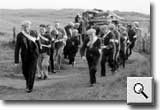 |
| |
|
|
 |
The
Collieston Auxiliary Coastguard Company is engaged in
‘Rocket Practice’ circa 1930. During the
testing of the equipment, a line would be shot from
the top of the Quarry over to Cransdale.
This would enable the Company of sixteen men to practise
operating the breeches buoy, a vital piece of life-saving
apparatus and one frequently used during a rescue operation.
At the end of the 1940’s ‘Rocket Practise’
was moved from Cransdale, to the cliff top above the
Peerman Braes on Forvie Moor where a pole was erected.
Similar to a ship’s mast and known as the ‘Rocket
Pole’, it was in use until 1992 when the Company
was re-graded from a Company of sixteen men to an Instant
Response Team of four, who currently train with their
colleagues in nearby Cruden Bay.
|
| |
|
|
| |
|
|
| |
A
Coast Guard life saving breeches buoy held by a young
woman. On either side of the woman stand two members
of the Collieston Coastguard Company while at the rear
is Charles Ingram, a resident of Cluny Cottages, who
was himself a member of the Collieston Auxiliary Coastguard
Company.
The Coastguard Company kept their life saving equipment
in the rescue apparatus store, known locally as ‘the
rocket shed’, at Cluny Cottages, which is where
the photograph was taken circa 1935.
|
| |
|
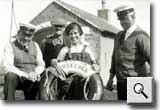 |
| |
|
|
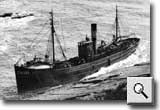 |
| Shipwreck |
| |
On 9th April,
1931 the trawler Rightway went ashore on rocks at Broadhaven,
south of Collieston. The Collieston Coastguard Company
heard the sounding siren at 0030 and reached the scene
at 0130. Three of the crew were taken ashore by breeches
buoy but the vessel then slid off the rocks.
The seven remaining crew had to jump on to an island
rock where they were told to stay until they were rescued.
Cliff ladders were then used. One end of a line was
attached to the bottom of the ladder and the other end
was secured to the heaving cane which was thrown over
the rock to the stranded men.
Scrambling along the ladder onto rocks near the base
of the cliff, the crew were then assisted up the main
cliff face. The last man was brought to safety at 04.00
and the Company was dismissed at 0630.
|
| |
|
|
| |
|
|
| |
| Winning
the Board of Trade Shield |
| |
The Collieston
Auxiliary Coastguard Company was called out to assist
after the drifter ‘Stephens’ ran aground
in bad weather some 200 yards offshore on the Forvie
Sands on November 8, 1956. For their part in the successful
rescue of the ship’s 10-man crew by breeches buoy,
the Company was awarded the Board of Trade Shield in
1957 for the best wreck service of the year.
|
| |
|
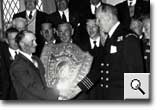 |
| |
|
|
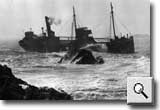 |
| Shipwrecks |
| |
The Middlesborough
coaster Brightside ran aground on rocks off Hackley
Head near Collieston on 24th April 1949 in thick fog.
The crew of nine got clear in a small boat and were
picked up by the Kirkcaldy drifter Noontide three hours
later and were put ashore at Aberdeen.
Before abandoning ship the Brightside’s master,
Captain J.W.Hopper of Sunderland, sounded the siren
for assistance. It jammed and brought Collieston Coastguards
and the Life Saving Brigade hastening to the cliff top.
Unable to see the coaster because of the thick fog,
they aimed rope-carrying rockets in the direction from
which the noise of the siren was coming. For a few minutes
the fog lifted and they saw one line had fallen across
the ship. They then realised that the crew had managed
to get away.
|
|
|
| |
|
|
| |
The breeches buoy is clearly
visible as are two members of the rescue party, happy
that on this occasion no lives were lost. To the right
leaning on the pole is Jack Ingram who was on holiday
at the time staying with his parents at No 2 Cluny Cottages.
Jack’s father, Charles Ingram, was a long serving
member of the Collieston Coast Guard Company.
|
|
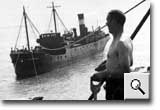 |
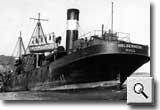 |
The
S.S. Holdernook ran aground on dangerous rocks a quarter
of a mile north of Hackley Head near Collieston on 21st
August, 1947. The Collieston Coastguard Company was
alerted and immediately proceeded to the scene intending
to assist in the rescue of the crew.
Having set up their rescue gear they had to keep it
in hand owing to the working of the vessel in the heavy
seas. The ship’s crew were hesitant to use the
breeches buoy due to the stormy conditions and were
subsequently rescued by the Newburgh Lifeboat and landed
safely at Collieston.
|
| |
|
|
| |
| |
|
|
| |
World War
2 |
|
| |
| |
A
form written in English and Norwegian, signed by a Norwegian
Brigadier and dated 29th December 1941. The pass was
issued to Lewis Mackie, a coast watcher and temporary
coastguard, to identify him to any Norwegian Forces
which he might meet while on patrol from Collieston
to the mouth of the River Ythan, part of the area also
covered by the Norwegian Brigade during the 1939-1945
World War.
Once while on patrol Lewis discovered a partly hidden
dinghy which had been brought up from the shore by some
Germans landing from a submarine. The Germans were eventually
caught further north in Moray.
|
|
 |
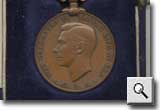 |
Rescue
at Sea
The
Bronze Medal for Gallantry in Saving Life at Sea
was
awarded to Richard (Dick) Ingram for his part in
the rescue of members of the crew of the Hull steamer ‘Lesrix’ which
ran aground on the rocks off Hackley Head during
a storm on January 26th 1942.
The obverse of the medal gives the effigy of King
George V1 and the Royal Cypher with the words ‘For Gallantry
in Saving Life at Sea.’ The ribbon is scarlet
with two narrow white vertical stripes.
Accompanied by his sister, Isabella, Dick travelled
to London where the medal was presented to him by King
George V1 at Buckingham Palace on 13th October, 1942.
|
| |
|
|
| |
|
|
| |
| |
Dick Ingram
is wearing the Bronze Medal for Gallantry in Saving
Life at Sea awarded to him by King George V1. The Hull
steamer Lesrix ran aground on the rocks off Hackley
Head during a storm on January 26th 1942.
Dick and George Ross, a young lad from the village,
rescued four men by breeches buoy from the bow of the
steamer but the unrelenting blizzard conditions caused
the stern of the Lesrix to break away and sink with
the loss of ten of her crew.
Dick’s heroism was recognised when he was awarded
the Gallantry medal for life saving at sea, while the
unfortunate young George received nothing more than
a rebuke from the headmaster for not turning up for
school that day.
|
| |
|
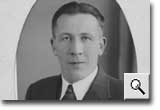 |
| |
|
|
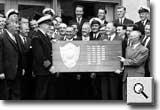 |
| Coastguards |
| |
On December
16, 1966, the m.f.v. ‘Semnos II’ ran aground
on a sandbank, in heavy seas, about 500 yards north
of the River Ythan. Belhelvie and Collieston Auxiliary
Coastguard Companies were alerted and immediately proceeded
to the scene of the shipwreck where well-rehearsed rescue
procedures were put into operation.
The shield awarded by The Board of Trade for the best
wreck service of the year, was jointly awarded to the
Auxiliary Coastguard Companies of Belhelvie and Collieston
for their part in the successful rescue of the six-man
crew. The presentation was held the following year at
the New Inn, Ellon.
|
| |
|
|
| |
|
|
| |
Coastguards |
|
| |
| |
The Collieston
Auxiliary Coastguard Company circa 1983. Coming into
being as an LSA (Life Saving Apparatus) Company in 1859,
there followed a subsequent regrading of the station
in 1925 when it was changed from a Regular to an Auxiliary
station with a full company of approximately 16 men.
The company is standing in front of the shed where the
rescue apparatus is stored, some of which is clearly
visible. The building, which can be seen on the extreme
right, is one of the former Coastguard Cottages.
|
| |
|
 |
| |
|
|
| |
Rescue
at Sea |
|
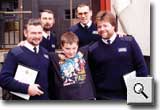 |
| |
Four members
of the Collieston Auxiliary Coastguard Company received
a commendation and special medallion from Gordon District
Council for their part in the rescue of Paul Forbes
on May 13 1993 after he had been washed into heavy seas
from rocks at the Needle’s E’e, Cransdale.
HM Coastguard in Aberdeen was alerted and the Company
from Collieston was called out to assist with the rescue.
Treacherous sea conditions at Collieston harbour meant
that a boat had to be launched instead from the beach
at Cransdale.
From the vantage point on top of the Needle’s
E’e, John directed his colleagues by radio to
where Paul was trying to keep afloat about one hundred
yards offshore. While Robin controlled the boat, Malcolm
and Jack managed to haul the boy on board. A search
and rescue helicopter from RAF Lossiemouth soon appeared
and Paul was winched on board and flown to hospital
in Aberdeen. He was found to be in the early stages
of hypothermia but otherwise OK.
|
| |
|
|
|
|
|
|
|
|
|
copyright
collieston's century 2003 |
|